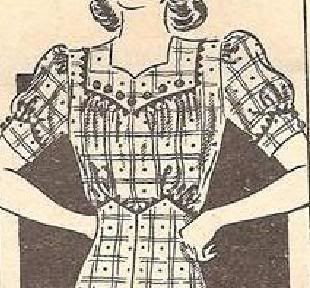Lauren
Distinguished Service Award
- Messages
- 5,060
- Location
- Sunny California
Great advice! I've done that, too, then had to undo the whole zipper and do over :eusa_doh:
Laughing Magpie said:Several of my vintage sewing and tailoring books earnestly instruct on the virtues of doing as many of your details - closures, trim, pockets, etc - first, so that you've got the benefit of sewing on flat pieces mostly. This assumes you've carefully drafted and fitted and marked everything, so it's not something I manage to do very often.
Jen
Lauren said:HA! True! Invisible zippers are my friends. If you can't see it, it's not un-period, right? (is un-period even a word?). There's a special invisible zipper foot for my machine that makes it nearly brainless, but I couldn't do it for the life of me without one. I'd say look into it if you want to put them in!
I, uh, haven't yet bothered to figure out the invisible zipper foot. What I do at present is baste by hand (no pinning! yay!) and sew with a piping foot.ShoreRoadLady said:Maybe this belonged in my other post in the Sewing FAQ, but oh well.You *can* put in invisible zippers without an invisible zipper foot. I found this out the hard way after the Coats & Clark zipper foot would not work with my machine. :rage: You just have to press the zipper out really flat and stitch carefully, close to the teeth, with a regular zipper foot. It took a little while to master, but it works fine now.
 Alden 403 Moc Toe Boot - Brown Chromexcel - $680 The classic "Indy" style Alden Boot in the classic Horween brown Chromexcel.
Alden 403 Moc Toe Boot - Brown Chromexcel - $680 The classic "Indy" style Alden Boot in the classic Horween brown Chromexcel.  Grant Stone Diesel Boot Dark Olive Chromexcel - #395 Goodyear welted, Horween Chromexcel, classic good looks.
Grant Stone Diesel Boot Dark Olive Chromexcel - #395 Goodyear welted, Horween Chromexcel, classic good looks.  Himel Bros. - The Ross Mk. 1 Leather Jacket Classic D-pocket motorcycle/aviator style jacket.
Himel Bros. - The Ross Mk. 1 Leather Jacket Classic D-pocket motorcycle/aviator style jacket. 
This has been discussed before, so here's just a thumbnail opinion. First, a "vintage" size 12 isn't one size: a 1920s 12 is smaller than a 1950s 12. Second, forget about size and focus on measurements - your conversion is off. In the 30s and 40s, bust 36 is size 18. In the 50s, a 16 would probably work; bust sizes change about 2" per size, so if a 12 is 32 inches, a 16 would be 36.Gigi said:I'm having a problem selecting the correct size pattern when buying authentic vintage patterns. I should wear a size 12 in vintage clothing items in general, as I wear a modern size 4-6, correct? I have some size 12 clothing from the 1950s. Yet, all the measurements for the vintage patterns that are size 12 are much smaller than my measurements (i.e. the pattern says 32 in. bust, when mine is 36). Sometimes this is frustrating as some patterns I look at only list the size and not the specific body measurements. If anyone here is a modern day 4-6 or has experience sewing for people of this size, what vintage pattern size should I get?
Gigi said:I'm having a problem selecting the correct size pattern when buying authentic vintage patterns. I should wear a size 12 in vintage clothing items in general, as I wear a modern size 4-6, correct? I have some size 12 clothing from the 1950s. Yet, all the measurements for the vintage patterns that are size 12 are much smaller than my measurements (i.e. the pattern says 32 in. bust, when mine is 36). Sometimes this is frustrating as some patterns I look at only list the size and not the specific body measurements. If anyone here is a modern day 4-6 or has experience sewing for people of this size, what vintage pattern size should I get?

